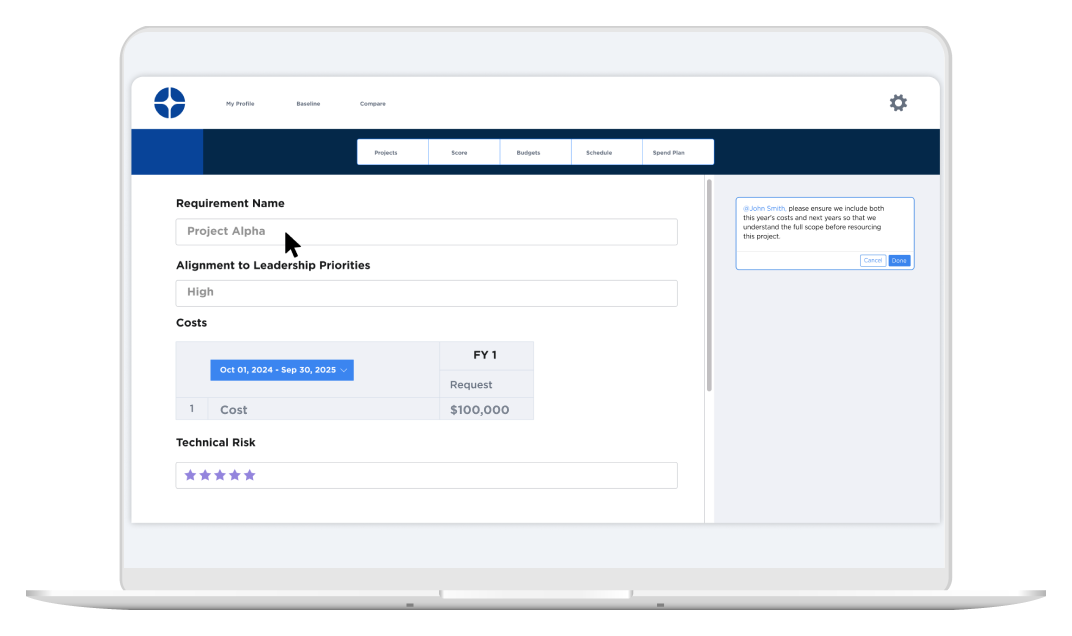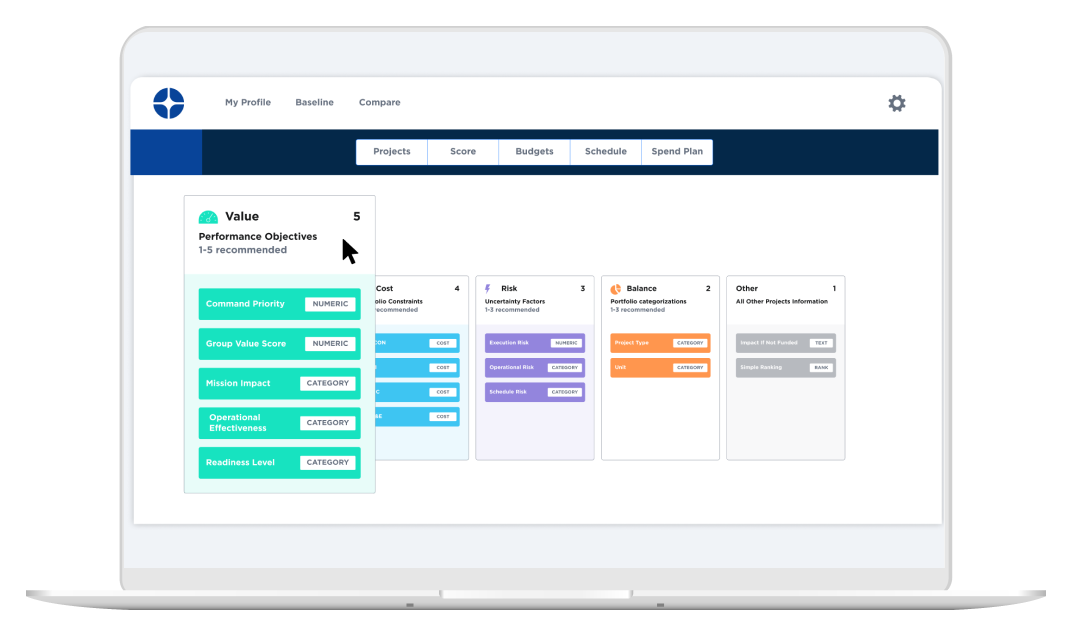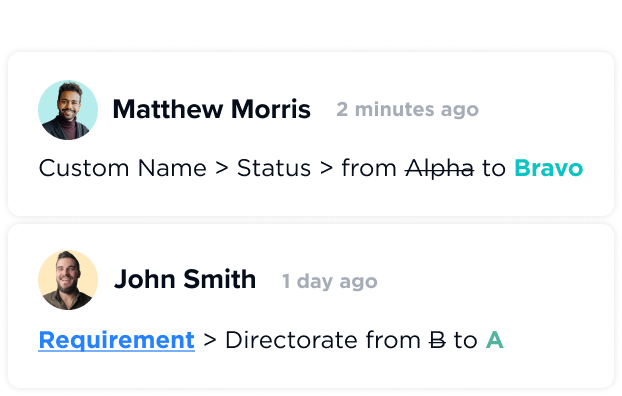In this article
The unfunded requirements (UFR) process has long been a cornerstone of military and government budgeting. It enables departments to identify critical gaps and reallocate unspent funds towards needs that exceed their current budget allocations. Despite its significance, the traditional UFR process is plagued with inefficiencies which in today's rapidly evolving environment is no longer sustainable.
In this blog, we'll explore the key challenges of the current UFR process and how modern solutions can address these issues, ultimately enhancing your department's ability to put its money where its mission is.
Here are three reasons why modernizing the UFR process is more crucial than ever.
1. Increased Operational Demands
Military operations are complex and require rapid adaptability, particularly during the year of execution. The unpredictable nature of today’s missions often leads to the need for greater reliance on unfunded requirements. The traditional UFR process, with its inherent delays and inefficiencies, cannot manage this effectively. This inability to quickly adapt to dynamic needs can compromise mission success.
2. Technological Advancements
The availability of purpose-built software, advanced data analytics, artificial intelligence, and automation tools presents an unprecedented opportunity to streamline and enhance the UFR process. Ignoring these technological advancements means missing out on significant efficiency gains – especially important as the Department of Defense struggles with recruiting talent.
3. Budgetary Pressures
With increasing demand for budget, the changing nature of warfare as seen with Great Power Competition, and the need for greater fiscal responsibility, there is a heightened focus on ensuring that every dollar is aligned with the mission.
Modernizing the UFR process can help departments make more informed and strategic funding decisions, maximizing the impact of limited resources at the subordinate command level all the way up to major commands.
The Not So Hidden Challenges of the Traditional UFR Process
Negative Impact on Operational Success
The inefficiencies of the traditional UFR process can have far-reaching consequences for a department's operational success. Delays in securing funding for critical needs can hinder mission readiness and responsiveness, while a lack of transparency and accountability can erode trust among stakeholders.
Furthermore, inadequate data management and resource constraints can lead to misallocated funds and missed opportunities to enhance capabilities. The end-of-year spending sprees further exacerbate these issues, diverting funds from strategic investments to short-term expenditures that may not align with long-term goals.
Time-Consuming, Error-Prone Procedures Waste Time and Delay Decisions
Many departments still rely on outdated data management practices, such as manually inputting data into spreadsheets and/or disconnected databases, to track unfunded requirements. This approach not only increases the risk of errors but also makes it difficult to aggregate and analyze data effectively.
Rising personnel costs dedicated to time consuming, low-value data collection is an undue tax on the system. This waste of precious resources further complicates and undermines the ability to manage unfunded requirements efficiently.
No Prioritization Framework Leads to Spending Sprees
Departments often operate under strict budget constraints, making it challenging to secure additional funding for unfunded requirements.
The traditional UFR process does not always provide a clear framework for prioritizing needs based on strategic objectives and potential impact, leading to one of the most problematic aspects of the UFR process: misaligned end-of-year spending sprees.
Faced with the "use it or lose it" budget mentality, departments often rush to spend remaining funds on whatever can be quickly purchased rather than strategically investing in long-term mission-critical needs. This reactive approach can lead to wasteful spending and missed opportunities to support core strategies effectively.
Modern Solutions to Transform the UFR Process
Today, commercial software purpose-built for the public sector can modernize the unfunded requirements process. While not always packaged as UFR software, the capabilities of this software will deliver efficiency, analytics, and the framework required to fundamentally improve the unfunded requirements process, from intaking requirements to understanding how much money is available to spend throughout the year. Below is an overview of the benefits software can provide to your agency.
Workflow Automation & Data Management

Modern UFR solutions leverage workflow automation to streamline the entire process, from requesting project submissions to final approval. Reducing the administrative burden, eliminating redundant steps, and automating the mapping of incoming data to a department-wide decision framework makes organizing, prioritizing, and allocating funds faster and more mission aligned.
By leveraging purpose-built analysis capabilities like scenario planning, departments can prioritize unfunded requirements based on potential impact and strategic importance. According to a McKinsey study, automation reduces time spent on a variety of traditionally manual tasks.
Strategic Resource Allocation

Modern UFR platforms provide a structured framework for evaluating and prioritizing unfunded requirements, ensuring that resources are allocated to the most critical needs.
By aligning funding decisions with potentially changing mission objectives departments can maximize the impact of their investments and increase mission success. This approach also mitigates the reactive "use it or lose it" spending mentality by enabling better forecasting and strategic planning.
These tools allow departments to identify and prioritize long-term investments throughout the year, reducing the need for last-minute spending sprees and ensuring that funds are used more effectively to support mission-critical objectives.
Enhanced Transparency and Accountability
The right platform offers real-time tracking and reporting capabilities, providing stakeholders with complete visibility into the status of their requests.

Additionally, in-app communication tools allow for discussion on requests directly within the software to have questions answered and forever associated with a request or decision.
This transparency not only improves accountability but also fosters a culture of trust and collaboration. With clear audit trails, performance metrics, and improved communication, departments can ensure that funds are allocated efficiently and aligned with strategic goals.
Conclusion
The traditional unfunded requirements process presents significant challenges that are hindering the ability to meet your mission. This is not a surprise with such an ingrained approach which has been used for decades. However, by embracing modern solutions like Decision Lens, departments can unlock efficiencies, enhance transparency, and improve resource allocation.
These advancements can transform the UFR process, ensuring that critical needs are met promptly and effectively, ultimately contributing to greater operational success.
By recognizing the limitations of the current system and investing in modern UFR solutions, your department can shift from a reactive to a proactive stance, ensuring that every dollar is invested strategically to support mission-critical needs.





